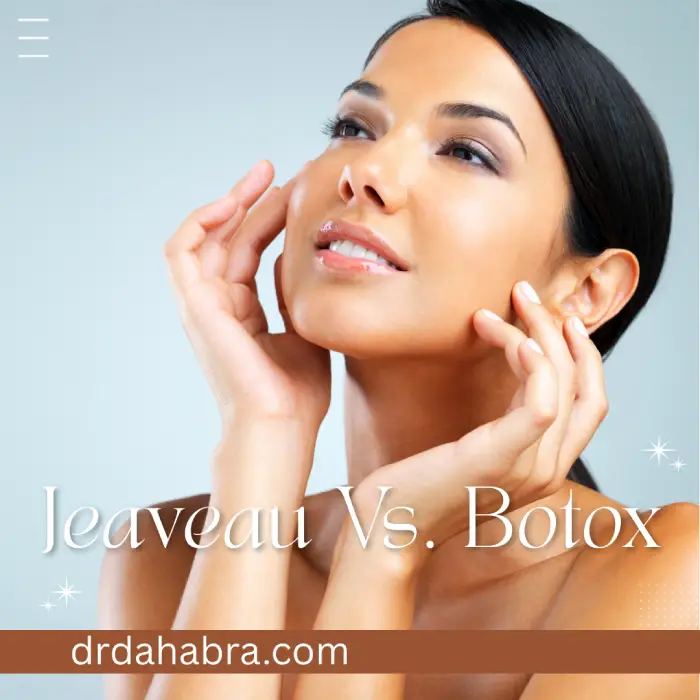Dysport vs Botox: Which Injectable is Best for Forehead Lines and Crow’s Feet?
What Are the Main Differences Between Dysport and Botox?
Botox vs Dysport: Confused on which to choose? We break down the key differences in cost, molecular spread, and crucial onset time (2–3 days vs. 5–7 days). This article discusses Botox vs Dysport: Key Differences Explained.
Understanding the comparison between Botox and Dysport is crucial before deciding on treatment for your face. Both are neurotoxin injections (botulinum toxin type A) that relax muscles to reduce dynamic wrinkles, but their formulation, diffusion, and dosing differ.
In a nutshell, Botox uses onabotulinumtoxinA, while Dysport uses abobotulinumtoxinA (i.e., onabotulinumtoxinA vs abobotulinumtoxinA). Dysport is more diluted, has smaller molecules, and tends to spread more easily (Dysport has a greater spread), making it better suited to larger areas like the forehead.
Botox’s larger molecules remain more localized, offering greater precision in smaller areas. While Dysport often shows results in 2 to 3 days, Botox may take 3 to 7 days to reach its full effect.
From a cost perspective, Dysport is often cheaper per unit; however, because more units are needed, the total cost of Dysport versus Botox can be comparable. Understanding the Botox Dysport unit ratio (often estimated at 2.5–3:1) is key.
Over time, many individuals will develop a preference for one or the other, but switching from Botox to Dysport is possible with dose adjustments and anatomical planning.
Table of Contents
1. How Does Molecular Size & Diffusion Shape Their Behavior?
2. Speed of Results: Dysport Faster Onset vs Botox Slower Onset
3. Dosage & Units: Understanding the Botox Dysport Unit Ratio
4. Treatment Area Suitability: Forehead, Crow’s Feet & Beyond
5. Duration & Longevity: Botox vs Dysport Longevity Compared
6. When to Choose Dysport: Ideal Use Cases & Benefits
7. When to Choose Botox: Precision & Localized Strength
8. What Looks More Natural: Botox or Dysport?
9. Which Injectable Is Best for Targeting ’11 Lines’ / Glabellar Lines?
10. Precise Wrinkles: Botox or Dysport for Crow’s Feet?
11. Is Dysport the Superior Choice for Extensive Forehead Lines?
12. Can Both Be Safely Used for Jaw Slimming (Masseter)?
13. Best Option for Fine Lip Lines: Botox or Dysport?
14. First-Time Users: Which Neurotoxin Should You Choose?
15. Frequently Asked Questions (FAQs)
16. Conclusion
17. References
1. How Does Molecular Size & Diffusion Shape Their Behavior?
One of the core scientific distinctions is the molecular size of neurotoxins and how that governs their diffusion.
Dysport’s molecules are smaller and more diluted, which means that once injected, they can diffuse or spread more extensively over surrounding tissues compared to Botox. This makes it more likely to cover a broader area from each injection point, which is helpful for broad zones like the forehead.
On the other hand, Botox utilizes a more concentrated formulation, resulting in less diffusion and higher focal strength. This helps when you want to target a particular line or avoid affecting nearby muscles that control eyelid or brow movement.
In short, molecular size & diffusion differences lead to trade‑offs: Dysport’s spread helps cover larger zones, while Botox gives more targeted control.
2. Speed of Results: Dysport Faster Onset vs Botox Slower Onset
A frequently cited advantage of Dysport is its faster onset of action.
Many patients begin to see softening of lines within 2‑3 days after a Dysport injection. By contrast, Botox typically takes 3‑7 days to manifest its effect fully.
Because of this, if you have an upcoming event and want quicker results, Dysport is often the preferred choice.
That said, complete optimization for both injections may take up to two weeks to settle, and results may continue improving slightly over that period.
3. Dosage & Units: Understanding the Botox Dysport Unit Ratio
One of the trickiest but essential factors is dosage and unit conversion.
Because Dysport is more dilute, it requires more units to achieve an equivalent effect. In clinical practice, many providers use a ratio of ~2.5 to 3 units of Dysport per 1 unit of Botox (i.e., 2.5–3:1) when converting.
So if you used 20 units of Botox in a region, a provider might plan for 50–60 units of Dysport to target the same area. Because of this, “cheaper Botox alternative” marketing must be assessed carefully; while Dysport may cost less per unit, the total expense often ends up being comparable.
It’s not that Dysport is strictly “cheaper,” it’s just that the pricing models differ.
Additionally, the neurotoxin dilution difference (the amount of saline used to mix the product) can affect the spread of the toxin (diffusion), the comfort of the injection, and the number of injection sites required. Providers often slightly adjust the dilution or needle technique based on the target area.
4. Treatment Area Suitability: Forehead, Crow’s Feet & Beyond
When comparing practical applications, the suitability of the treatment area for each product becomes critical.
Dysport is often preferred for larger areas, such as the forehead, where its ability to spread more easily helps smooth broad zones. Due to this spread, Dysport can deliver a more even and smoother effect over a wider surface area.
Botox, being more concentrated and less diffusive, is often better suited for precise, smaller, or high-risk areas, such as crow’s feet or delicate lines around the eyes. The localized nature helps avoid unintended spread to adjacent muscles (e.g., eyelid droop). Because of Botox’s precise control, it remains a go-to for treating “targeted areas.”
Some injectors might also prefer Botox for “best injectable for ’11s” when they want tight control.
In practice, many clinicians employ a hybrid approach, using Dysport in broad zones and Botox in precise zones; however, this approach relies on experience and anatomy.
5. Duration & Longevity: Botox vs Dysport Longevity Compared
How long do these neurotoxins last?
In general, both Botox and Dysport offer results that last 3 to 4 months, although individual variation is significant.
Some studies suggest that Dysport may produce a slightly longer duration of effect in specific anatomical regions, likely due to its greater amount of active neurotoxin per FDA-approved dose (i.e., a higher active ingredient “load”). For example, a study reported a mean duration of clinical benefit of ~105.9 days for Dysport vs ~85.4 days for Botox in one sample set.
However, many head-to-head trials (e.g., in forehead, glabellar, and periorbital wrinkles) show no statistically significant difference in duration when comparable dosing ratios are used.
In practice, longevity may depend more on factors such as dose, injection site, muscle strength, prior treatments, and patient metabolism, rather than the intrinsic superiority of one product over another.
6. When to Choose Dysport: Ideal Use Cases & Benefits
You may lean toward Dysport in several circumstances.
First, when you want faster visible results, Dysport’s faster onset (2–3 days) gives it an edge.
Second, when treating a larger area, such as broad forehead lines, its diffuse spread can help smooth over a wider zone with fewer injection sites.
Third, some patients prefer a softer or more natural look, which can result from the gentler spread of the treatment rather than hyper-targeted freezing.
Fourth, in some practices, Dysport offers a modest per-unit cost advantage, although the higher total number of units required offsets this advantage.
Dysport’s pros also include slightly less injection discomfort in some reports, though evidence is mixed.
However, those benefits must be weighed against its less precise control, greater diffusion risk near delicate anatomy, and potential for unwanted muscle impact if dosage or placement is not well controlled.
7. When to Choose Botox: Precision & Localized Strength
Botox remains preferred when precision matters most.
Because Botox is more concentrated, it stays more localized, making it safer for delicate areas where unwanted diffusion is a risk (e.g., near the eyelids, brow, or “crow’s feet” margins)..
When addressing small, deeper lines or when you want maximal control over the shape and direction of effect, Botox gives the injector better predictability. In areas that require careful preservation of adjacent muscle function, Botox is often a safer option.
In some cases, Botox may last a bit longer in fine, localized areas, though data is mixed.
For patients who already respond well to Botox, switching to Dysport may pose unpredictability (though it is possible), so staying with Botox can make maintenance more consistent.
The injector’s familiarity and experience with Botox also often tilt the choice.
8. What Looks More Natural: Botox or Dysport?
One common patient concern is, “Which looks more natural?”
Many people claim that Dysport yields a softer, more natural result because its diffusion softens the edges of treated zones, resulting in a less “boxed” appearance and gentler blending into untreated areas. (“Some patients report a more natural look with Dysport”).
That said, Botox can also yield a natural result in the hands of an expert, mainly when lower doses are used and placement is precise. If overdone, any neurotoxin can look “frozen.”
The key is the injector’s skill, careful planning, and understanding of patient anatomy. Many experienced injectors emphasize that whether Botox or Dysport looks more natural depends far more on technique than brand.
9. Which Injectable Is Best for Targeting’ ’11 Lines’ / Glabellar Lines?
11 lines’ (glabellar frown lines) are one of the most common aesthetic targets.
Both Botox and Dysport are effective for glabellar lines; Botox is FDA‑approved for glabellar lines, and Dysport is also FDA‑approved for that indication.
In practice, many injectors choose Botox for glabellar lines when precision is essential to avoid eyelid or brow droop. If a broader zone is involved or if the muscle is powerful, Dysport (with appropriate unit conversion) may offer a more distributed effect.
The choice often comes down to injector preference and patient anatomy. Some trials show similar outcomes when correct conversion dosing is applied.
If the goal is to soften the lines with minimal risk, many providers start with a moderate dose of Botox and then adjust in follow‑ups, or use Dysport in combination zones.
10. Precise Wrinkles: Botox or Dysport for Crow’s Feet?
Crow’s feet are delicate, curved lines around the lateral eye.
Due to the risk of eyelid droop (ptosis) resulting from diffusion into the levator muscle, many injectors prefer Botox for crow’s feet, as it offers greater control over the treatment. The ability to localize the effect is crucial in this zone.
However, Dysport has been used successfully for crow’s feet, especially by well-trained injectors who carefully control diffusion (e.g., by limiting the number of units per injection, using small volumes, and meticulous placement).
Some studies have even suggested a slight advantage of Dysport over crow’s feet in wrinkle effacement when using a 3:1 ratio, although those findings are not definitive.
Ultimately, when taming crow’s feet with minimal risk of eyelid side effects, many clinicians lean toward Botox.
11. Is Dysport the Superior Choice for Extensive Forehead Lines?
When you’re dealing with a vast expanse of forehead, multiple horizontal lines, and movement across the brow, Dysport is often considered superior because its diffusion and spread allow smoother coverage from fewer injection points. This makes it easier to treat extensive forehead lines more evenly.
That said, injectors must be cautious because too much spread or high dosage can potentially cause brow asymmetry, heaviness, or unintended weakening of adjacent muscles. Careful planning, dose control, and technique are vital.
Some split‑face trials comparing Botox and Dysport in upper face lines failed to find significant differences when proper dosing ratios were used. However, many practitioners still prefer Dysport as a favorable choice for broad forehead zones.
12. Can Both Be Safely Used for Jaw Slimming (Masseter)?
Yes, both Botox and Dysport can be used in the masseter muscle to slim the jawline, reduce teeth grinding (bruxism), or soften the lower face contour.
However, some injectors prefer Botox because of its more controlled and localized effect, which reduces the risk of diffusion into adjacent muscles (e.g., muscles of chewing or the smile).
Others use Dysport successfully with dose adjustments and anatomical precision. The choice may hinge on the size of the masseter: for a huge muscle mass, Dysport’s diffusion might help cover more territory; for moderate masseters, Botox allows more predictable targeting.
Safety profiles and side effect risks are comparable when administered by experienced injectors; however, the margin for error is smaller in the muscle tissue of the motor muscles.
13. Best Option for Fine Lip Lines: Botox or Dysport?
Fine “smoker lines” or perioral lines present a challenging zone.
Due to their small size and proximity to the muscles controlling lip movement, Botox is often preferred because of its greater precision and lower risk of diffusion. You want to avoid weakening muscles that control lip mobility, speech, or symmetry.
Dysport’s greater spreading tendency may lead to unwanted effects in adjacent muscles that support the mouth. For that reason, many injectors avoid using Dysport frequently for lip lines or limit the dosage and choose it on a case-by-case basis.
When Dysport is used, it’s often in microdoses and with extreme caution.
14. First-Time Users: Which Neurotoxin Should You Choose?
If it’s your first time doing injectables, the decision between Botox and Dysport often comes down to risk tolerance, goals, and injector comfort.
Botox is somewhat more forgiving for novices because of its predictability and more localized effect (“Botox targeted areas”). Many providers start new patients with Botox for that reason.
However, if your injector is very experienced with Dysport, the faster onset and softer blending may be attractive. If you choose Dysport first, beware of over-treatment or excessive spread.
Whatever you choose, start conservatively, allow follow-up adjustments, and aim for incremental improvement. Always ask your provider about their experience, the safety profile of the neurotoxin, and how they manage both products.
15. Frequently Asked Questions (FAQs) about Botox vs Dysport: Key Differences Explained
Q1. How much longer does Dysport last than Botox?
Concise Answer: Dysport may last slightly longer in certain patients, but generally both last ~3–4 months.
Detailed Answer: In comparative studies, Dysport has sometimes shown a modest advantage in duration (e.g., 105.9 days vs. 85.4 days in one study); however, many head-to-head trials have found no significant difference in longevity when proper dosing is used.
In practical terms, individual metabolism, injection site, and dose often take precedence over the brand.
Q2. Why do people prefer Dysport?
Concise Answer: Many prefer Dysport because of its faster onset, broader smoothing, and softer blending.
Detailed Answer: Dysport’s appeal lies in its quicker visible effect (often 2–3 days), its ability to diffuse more smoothly across a zone, and the perception of a more natural appearance rather than a strict frozen look.
Some patients also find Dysport slightly less painful or more comfortable. That said, preferences vary, and some choose Botox for precision and predictability.
Q3. Are Botox and Dysport simply different brand names for the same drug?
Concise Answer: No, they are different formulations of botulinum toxin A (onabotulinumtoxinA vs abobotulinumtoxinA).
Detailed Answer: Although both are neurotoxins of type A, Botox is onabotulinumtoxinA, and Dysport is abobotulinumtoxinA. The differences in formulation, dilution, accessory proteins, molecular size, and diffusion behavior result in varying behaviors during dosing, spread, onset, and clinical use.
The neurotoxin safety profile is similar overall, but they are not identical “brands” in function.
Q4. Do certain muscle groups respond better to one neurotoxin over the other?
Concise Answer: Yes, broader muscles (like forehead or masseter) may respond better to Dysport, while fine or delicate groups (around the eye) may favor Botox.
Detailed Answer: Because Dysport diffuses more readily, it can cover larger muscles more efficiently, whereas Botox’s precise localization is advantageous in small, delicate muscles (e.g., orbicularis oculi for crow’s feet).
Some injectors tailor the choice to the anatomy: masseters or strong frontalis muscles might tolerate Dysport well; periorbital lines often favor Botox for safety reasons.
Q5. Why do some patients report a more “natural” look with Dysport?
Concise Answer: Because Dysport diffuses more, it can soften transitions and avoid harsh edges, creating a gentler effect.
Detailed Answer: The greater spread of Dysport allows a smoother gradient between treated and untreated zones, reducing noticeable demarcation lines. For many patients, this softer blending results in a more “natural” look compared to tightly localized freezing.
That said, natural aesthetics depend heavily on dose choice, injection technique, and patient anatomy rather than simply brand.
Q6. What is the typical downtime and post‑treatment care for each injectable?
Concise Answer: Downtime is minimal for both. Avoid rubbing the area, engaging in strenuous exercise, and lying flat for several hours after treatment.
Detailed Answer: After either Botox or Dysport injection, patients often experience mild redness, swelling, or bruising, which resolves in a few days. Post-treatment care typically includes avoiding touching or massaging the area for 4–6 hours, refraining from vigorous exercise for 24 hours, and maintaining an upright position for a few hours.
Both injectables have essentially identical post-care protocols, and downtime is negligible.
Q7. Can Botox and Dysport be used together during the same treatment session?
Concise Answer: Yes, some providers mix or use both in different zones in the same session, but this requires precision and experience.
Detailed Answer: Using both Botox and Dysport in a single session is possible and sometimes done, for example, using Dysport for a broad forehead zone and Botox for delicate periorbital areas.
However, combining them increases complexity in dose conversion, diffusion control, and safety margin. Only very experienced injectors typically mix them, and they do so cautiously.
Q8. Does Dysport truly kick in faster than Botox, and by how many days?
Concise Answer: Yes, Dysport often shows effect in 2–3 days, compared to 3–7 days for Botox.
Detailed Answer: Many clinical guides and observational reports cite that Dysport demonstrates noticeable effect within 2–3 days (i.e., faster onset), while Botox usually requires 3–7 days to show full effect. That said, both may continue to improve for up to two weeks after the injection.
Q9. Which one is better for getting rid of deep ’11 lines’ between the eyebrows?
Concise Answer: Both can work well; many choose Botox for better control, but Dysport (with correct dosing) is also effective.
Detailed Answer: When treating deep glabellar frown lines, many injectors prefer Botox due to its precision and lower risk of diffusion near the eyelid muscles. However, Dysport can also be effective when administered appropriately (with a 2.5–3:1 conversion ratio).
Some trials show comparable effectiveness at proper dosages. It often depends on the patient’s anatomy, muscle strength, and the injector’s experience.
Q10. Does Dysport give a more “frozen” look, or is it softer than Botox?
Concise Answer: Dysport tends to give a softer, less “frozen” look; Botox may appear more rigid if overdone.
Detailed Answer: Because Dysport spreads more and diffuses somewhat, it often yields a gentler smoothing effect. In contrast, Botox’s localized precision can result in a more obvious blockade if high doses are used.
However, either can be overused and freeze” too much. When properly dosed and planned, both can deliver natural, balanced results.
Q11. Is it normal to feel a stinging or burning sensation more with Dysport injections?
Concise Answer: Some patients report more transient discomfort with Dysport, but evidence is inconsistent.
Detailed Answer: Anecdotally, a few patients mention a slight extra sting or burning with Dysport injections, possibly due to dilution, pH, or buffer composition.
Some studies note that Dysport is less painful, while others show no difference in pain. Overall, any discomfort is mild, transient, and similar to the sensations associated with standard injections.
Q12. Which product works best for getting rid of crow’s feet without eyelid droop?
Concise Answer: Botox is often preferred for crow’s feet to minimize the risk of diffusion, although skilled injectors can use Dysport.
Detailed Answer: Crow’s feet area lies close to eyelid‑raising muscles, so diffusion is a genuine concern. Doctors often favor Botox because its lower diffusion helps reduce the risk of eyelid droop (ptosis).
Dysport may be used, but only with cautious dosing and placement to avoid unintended spread.
Q13. Is there a specific type of wrinkle or area where Botox is strictly better than Dysport?
Concise Answer: Yes, in delicate, narrow, or high‑risk zones (e.g., eyelids, around the eyes, precise brow shaping). Botox’s precision often makes it a safer option.
Detailed Answer: In areas where even small unintended diffusion could cause functional or aesthetic problems, such as near the levator muscle of the eyelid or delicate fine lines in the lips or around the eyes, Botox’s localization provides a safety margin.
In these zones, many practitioners strongly prefer Botox to control the spread and reduce the risk of side effects.
Q14. What are the chances of getting a droopy eyelid (ptosis) with Dysport due to its spread?
Concise Answer: The risk of ptosis is low for both, but Dysport’s greater diffusion slightly increases the risk in sensitive zones if not placed carefully.
Detailed Answer: Eyelid ptosis is a known potential adverse event with any botulinum toxin injection near the orbital area. Because Dysport diffuses more, there is a higher theoretical risk of diffusion into the levator muscle if injections are not accurately placed.
In practice, when doses are conservative and placed carefully by experienced injectors, the incidence is rare and comparable between products.
Q15. Which one is more effective for treating the masseter muscle to achieve a slimmer jaw?
Concise Answer: Both can be effective; many providers prefer Botox for control, but Dysport may be used in larger muscles if managed carefully.
Detailed Answer: For masseter slimming, both Botox and Dysport are viable. Many practitioners choose Botox to limit diffusion into nearby muscles (e.g., those for chewing or facial expression).
However, for larger or stronger masseters, Dysport’s diffusion advantage may be beneficial in covering a greater volume of muscle fibers. The key is dose calibration, anatomical knowledge, and injector experience.
16. Conclusion: Botox vs Dysport: Key Differences Explained
Navigating the choice between Botox vs Dysport is less about declaring a universal “winner” and more about aligning your face, goals, and injector’s skill.
Dysport’s faster onset, greater spread, and often somewhat lower per-unit cost make it an appealing option for broad zones, such as the forehead, and for those who want quicker visible results. Meanwhile, Botox’s precision, controlled diffusion, and established safety record make it a go-to treatment for delicate, localized zones, such as the crow’s feet or periorbital lines.
When considering Dosage, Units, Duration, Molecular Spread, and Safety, the devil is in the details. The well‑practiced injector knows how to balance Botox Dysport unit ratio, adjust for neurotoxin dilution difference, and modulate diffusion to avoid complications.
The clinical evidence to date, while not always definitive, suggests both products are safe, effective, and often interchangeable when used judiciously.
If you are deciding between these injectables, the best path forward is a tailored consultation, where we assess your facial anatomy, wrinkle pattern, tolerance for diffusion, and timing needs (e.g., for a special event).
A skilled provider can help you choose the best injectable for 11s, forehead lines, crow’s feet, or even hybrid strategies that combine both.
In many cases, the difference lies not so much in the brand as in the art of injection.
We have covered everything about Botox vs Dysport: Key Differences Explained.
Botox vs Dysport: Key Differences Explained
Botox vs Dysport: Which Powerful Choice Delivers Better Wrinkle Results? With Dr. Dahabra. Why wait to unlock your beauty?
Call us now at (954) 595-2607 or book online. Your journey begins with just a click or a call.
Embrace the beauty, embrace innovation – Embrace You.
17. References
(Ranoux et al.)
Source / Institution: Journal of Neurology, Neurosurgery & Psychiatry / French / European neurology groups
Brief: This crossover study compared the clinical potency and equivalence of Botox and Dysport in patients with cervical dystonia, thereby helping to establish unit conversion ratios for these products.
AbobotulinumtoxinA (Dysport®), OnabotulinumtoxinA (Botox®), and IncobotulinumtoxinA: A Comparative Review
(Field et al.)
Source: PMC / National Institutes of Health
Brief: A detailed comparative review of the three major BoNT‑A formulations (including Dysport and Botox), covering mechanism, clinical uses, dosing, and side effect profiles.
(Karsai et al.)
Source: Archives of Dermatology / U.S. dermatology research
Brief: A split‑face randomized trial comparing 12 U Botox vs 36 U Dysport in the forehead, assessing wrinkle reduction and EMG changes over time.
(Michaels et al.)
Source: Aesthetic Surgery Journal / American Cosmetic Surgery Research
Brief: This study directly compared Botox and Dysport in aesthetic use, evaluating efficacy, safety, and patient satisfaction in wrinkle treatment.
Comparative Efficacy, Safety, and Cost‑Effectiveness of Botulinum Toxin Type A Therapies
(Danchenko et al.)
Source: Journal of Children’s & Adolescents’ Muscle / International Therapy Comparison
Brief: This work reviews various BoNT-A formulations (including Botox and Dysport) in therapeutic (non-cosmetic) settings, comparing their effectiveness, safety, and cost.
(Yun et al.)
Source: Movement Disorders/Neurology Movement Disorder Center
Brief: Comparison of the 2.5:1 conversion ratio in treating cervical dystonia, evaluating efficacy and tolerability across both products.
OnabotulinumtoxinA and AbobotulinumtoxinA Dose Equivalence: A Systematic Literature Review
(Dashtipour et al.)
Source: Movement Disorders Clinical Practice/movement disorders specialists
Brief: This review scans multiple clinical trials across medical specialties to compare dose equivalence, safety, and conversion practices between Botox and Dysport.
AbobotulinumtoxinA: A 25‑Year History
(Monheit, A. / review)
Source: PMC / dermatology & aesthetic research
Brief: A historical and clinical review of Dysport (abobotulinumtoxinA), covering development, mechanism, clinical uses, and safety over decades.
Real‑World Dosing of OnabotulinumtoxinA and AbobotulinumtoxinA
(Kent et al.)
Source: MDPI / toxin, pharmaceutics & real usage data
Brief: Examines real‑world clinical practices comparing onabotulinumtoxinA (Botox) and abobotulinumtoxinA (Dysport) dosing patterns, especially in ophthalmologic settings like blepharospasm.
(Esquenazi et al.)
Source: Frontiers in Neurology/Neurorehabilitation Research
Brief: Although not purely aesthetic, this article reports on the longevity (duration of effect) and retreatment intervals of Dysport (aboBoNTA) in spasticity and dystonia, which helps inform comparative durability.




